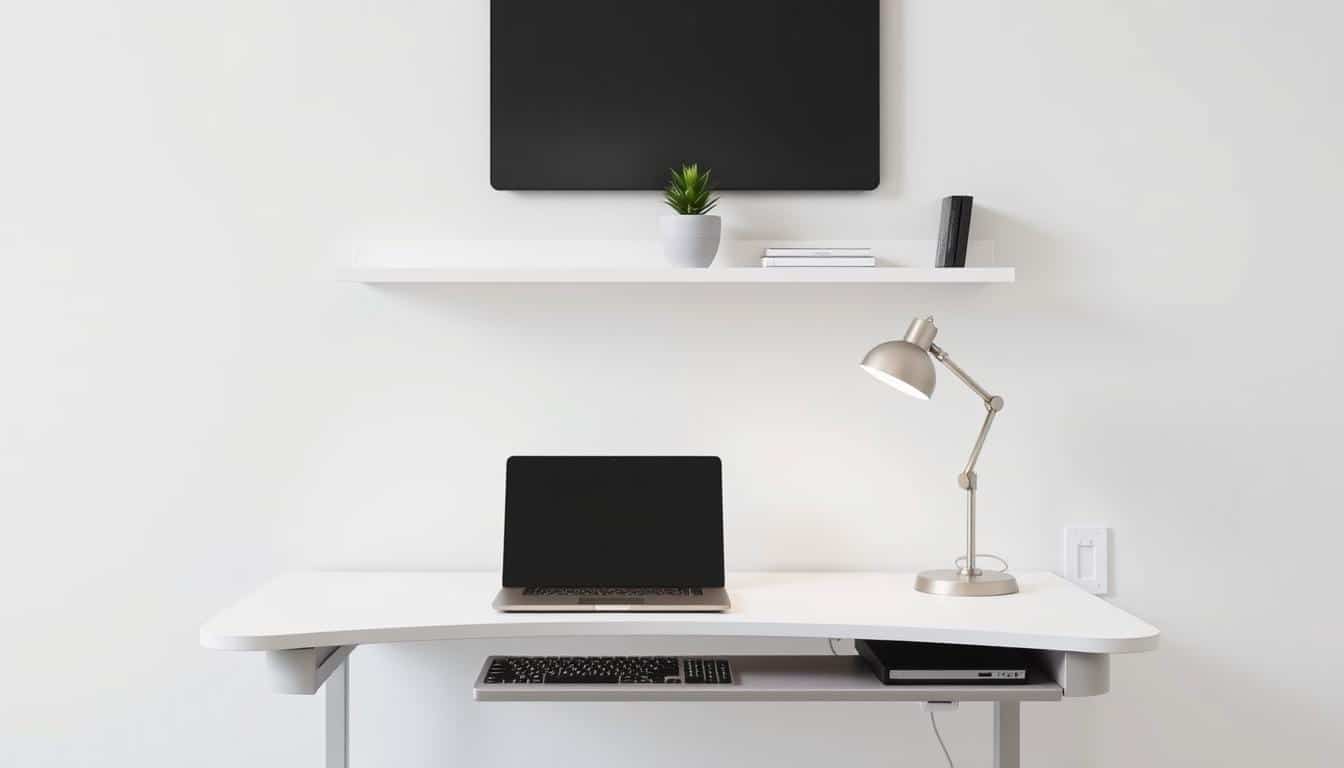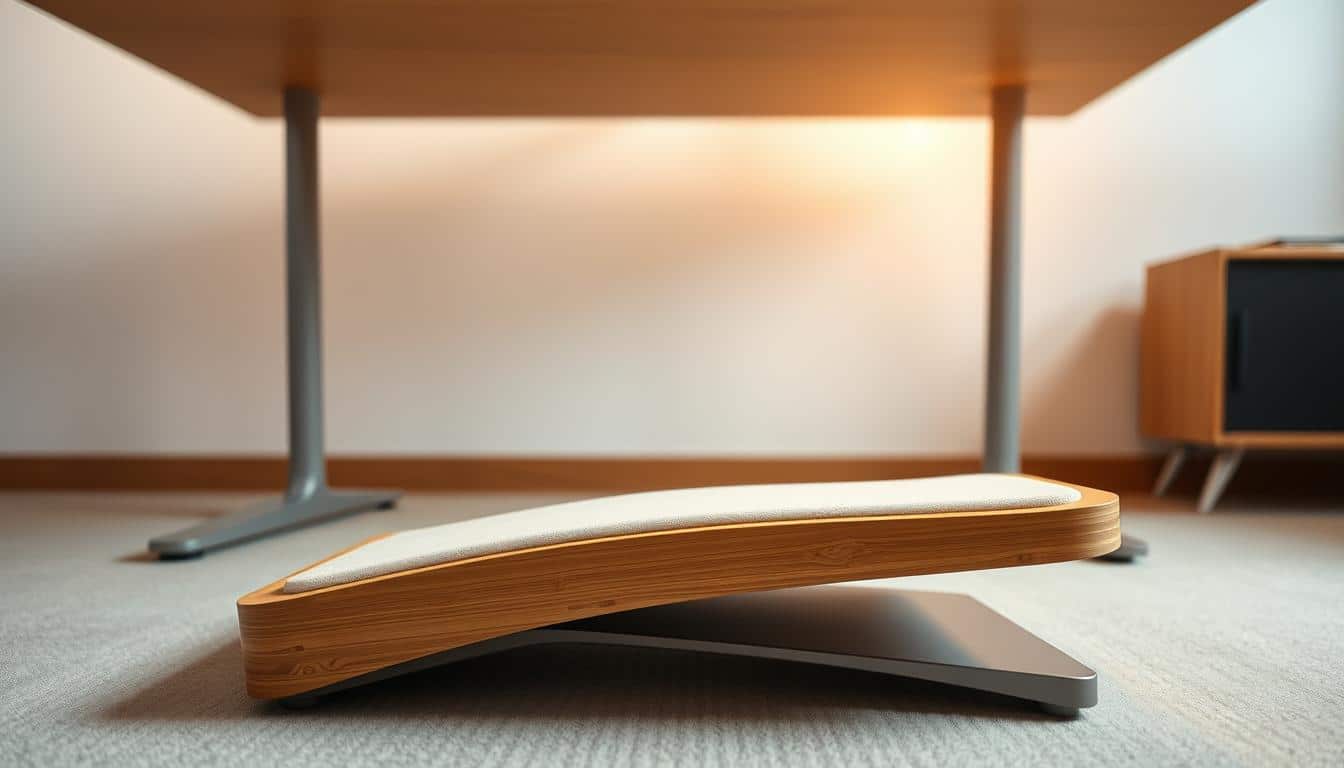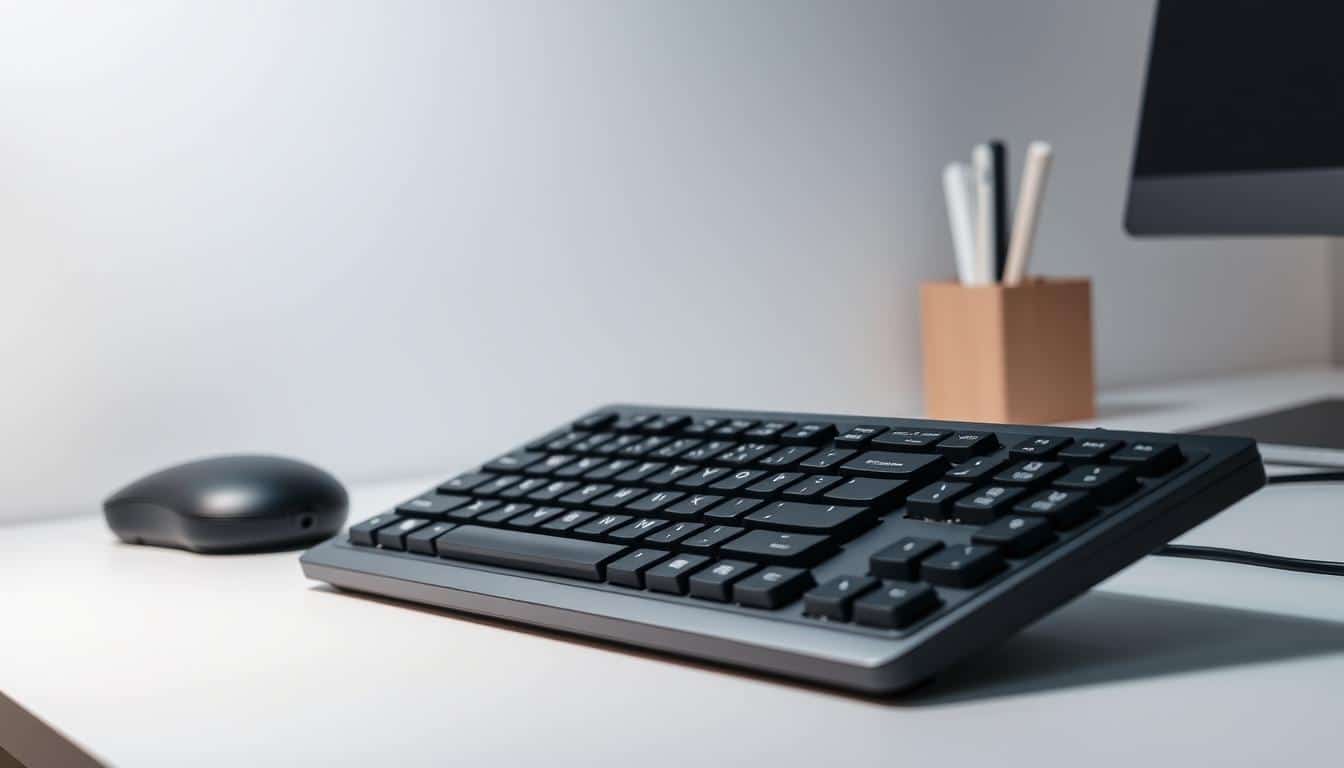In today’s world, a minimalist home office is key for good productivity and well-being. A workspace with ergonomic design offers comfort and efficiency. It also looks clean, helping you focus better. This guide will cover what you need for an organized, stylish office space. You’ll learn how to pick the right furniture and arrange your space well. Each part helps make your minimalist office welcoming and effective.
Understanding Ergonomics in a Home Office Setting
Ergonomics makes sure workplaces meet users’ needs, promoting comfort and efficiency. It’s crucial for a home office to reduce discomfort and strain. Thinking about ergonomics involves several important steps.
These design principles focus on:
- Adjusting desk height so arms are comfortable while typing.
- Choosing a chair that supports the lower back well.
- Putting monitors at eye level to avoid neck strain.
- Keeping the right distance from the screen to prevent eye fatigue.
Using these ideas not only makes a workspace better but also helps with well-being. Proper ergonomic habits bring long-term health perks. They boost productivity and make work more enjoyable. A thoughtfully set up home office changes how we handle daily tasks. It encourages creativity and focus.

The Benefits of a Minimalist Home Office
A minimalist home office boosts productivity by keeping spaces clear of clutter. This simplicity helps individuals focus better, free from distractions common in busier areas. With just the essentials, people find it easier to think clearly, which makes them more efficient.
Even in such a simple setting, you can still have a creative space. This is done by organizing well and making smart design choices. Everything you need stays within reach but doesn’t overcrowd the space. This keeps your office looking good while being practical for any task.
Key Components of an Ergonomics Minimalist Home Office
Creating a minimalist home office that focuses on ergonomics means adding key things. These include a comfortable desk and chair. They are essential for setting up a workspace that works well.
Adding an adjustable standing desk to your office is a smart move. It lets you switch between sitting and standing. This is good for your posture. Also, an ergonomic chair with support for your lower back is important. It helps keep your spine aligned and reduces back pain.
When picking items for a minimalist office, choose simple yet effective tools. A solution for keeping cables organized can make your space look neat. This makes for a peaceful place to work. A clean setup helps spark creativity and focus.
To wrap up, a good home office blends ergonomics with a sleek design. Focus on these essentials to make your office not just stylish but also supportive of your health and productivity.
Office Desk Selection for Optimal Ergonomics
Finding the perfect office desk is key for great ergonomics at work. A smart choice in desks can boost health, comfort, and how much you get done. Look for a desk that lets you change from sitting to standing without hassle. This feature helps you move more and stay alert all day.
Make sure your desk fits nicely in your space and leaves room for everything you need. Desks that move up and down, like the Autonomous SmartDesk 2, are great. They let you switch between sitting and standing. This cuts down on the harm of sitting too much for a healthier life.
Pick a desk that meets your ergonomic needs and makes your workspace better. The right desk helps you feel comfortable and productive, which is key for doing well at work.
Choosing an Ergonomic Chair for Comfort and Support
Getting an ergonomic chair is key for a cozy home office. These chairs help keep your back healthy by supporting it the right way. Look for chairs that let you change their height and armrests to fit what you like.
The Hbada Ergonomic Office Chair is great for both comfort and support. It helps keep your spine aligned, which is important when sitting for a long time. A good ergonomic chair can help avoid pain and problems from sitting wrong.
Ergonomics Minimalist Home Office Layout Tips
To create a minimalist home office that works well, focus on layout tips that boost functionality. Make sure your desk and computer screen are at eye level. This will help avoid neck and eye strain, making work more comfortable.
It’s also important to arrange your furniture to use space wisely. Put things you use a lot, like your keyboard and mouse, close to you. This step will help your work flow better and make you more productive.
Using vertical space for storage helps clean up your office. Put shelves or hang organizers on the wall. This keeps things you need within reach but off your desk. It makes your office look neat and helps you focus and be creative.
Essential Equipment for Productive Work
To make a workspace productive, you need the right gear. Adding top-notch productivity tools and gadgets can really boost your efficiency. Begin with ergonomic items for comfort, such as keyboards and mice that adjust. Brands like Logitech offer great wireless options that let you skip the wire mess.
Keeping cables organized is key to a neat desk. Cable organizers help keep your space clean, leading to better concentration. Also, try using digital timers to keep track of tasks and stay productive all day.
Choosing the best home office essentials helps make a place where focus and creativity thrive. Keep these tips in mind when arranging your workspace.
Importance of Proper Lighting in Your Workspace
Proper lighting is key to a good workspace. It affects how well you work and feel. Try to get as much natural light as possible. Natural light boosts your mood and lessens eye strain. This makes working more comfortable.
When you can’t get enough sunlight, desk lamps are a great help. Adjustable lamps let you shine light right where you need it. Screen bar lamps light up your desk without glaring on your computer. Good lighting makes for a better work environment.
Decluttering Your Space for Better Focus
Decluttering is key to creating a focused, minimalist home office. By using smart decluttering methods, you can organize your space better. This makes staying productive easier. Adding desk organizers helps keep important items close and cuts down distractions.
Using cable management stops wire tangles and reduces visual mess, making your space calm. Checking your desk regularly helps keep only what’s necessary, helping you think clearer and make better choices.
Add storage like filing cabinets or shelves to keep items you don’t always need out of the way but organized. These steps not only make your area better for work, but they also enhance your mental health.
Creating a Personalized Yet Minimalist Office Vibe
To make your workspace both personal and minimalist, start by choosing items that reflect you but keep things simple. This includes:
- Plants that bring life and freshness to your space
- Personal art pieces that spark inspiration
- Customized desk pads that enhance both functionality and design
Adding personal touches helps decorate your office and boosts inspiration. Strive for a mix of decor and neatness, making sure everything has a purpose. This way, you’ll create a workspace that’s both creative and minimalist.
Conclusion
Creating an office at home that is both simple in design and ergonomic is crucial. This approach enhances comfort and boosts productivity. By adopting ergonomic principles, people can reduce the stress of long work hours while enjoying a minimalist office.
Choosing the right furniture and a smart layout makes an office not just attractive but practical too.
Keeping your space free from clutter helps keep you focused. Using these methods, any home office can become a center of efficient work. The advice in this article shows how ergonomics and minimalism go hand in hand. Remember, combining functionality with simplicity is essential for success.
To wrap up, an office designed with care can greatly increase work performance. Applying these ideas allows for a personal and simple space that boosts productivity. These final words encourage you to make your work area better. This benefits both your health and your work.



